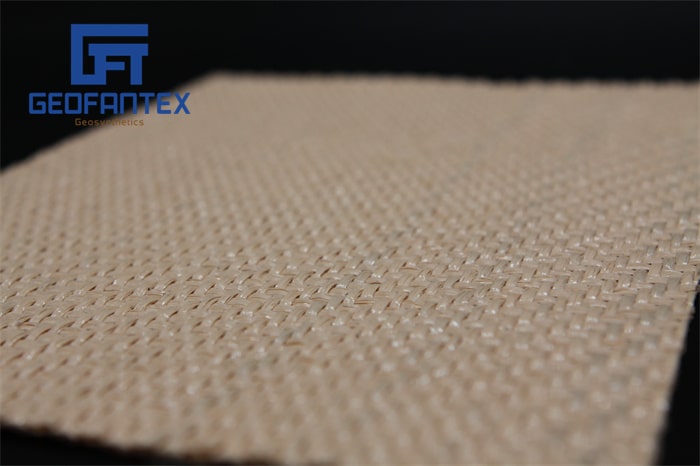What Is Woven Geotextile Fabric?
Essentially, woven geotextile is made by weaving individual yarns on a loom to create a uniform length. Different materials such as slit films, fibrillated yarn, and monofilaments can be used, but the weaving technique is constant regardless of the material used.
This ensures that the woven geotextile fabric is strong, making it an excellent choice for applications like road constructions, beneath driveways, residential streets, and highways. Woven geotextiles are not as permeable with a few exceptions, so they are not the best choice for drainage projects. Instead, they are excellent for long-term separation and reinforcement applications, and they resist corrosion.

What Is Nonwoven Geotextile Fabric?
Nonwoven geotextiles are manufactured by binding short and long fibers together through needle punching or other alternative methods. Usually, heat treatment is applied to ensure the geotextile’s strength is improved.
Nonwoven geotextiles are usually made using synthetic materials such as polyester or polypropylene and they are permeable. They are best used in projects that require protection, filtration, separation, and drainage. However, they are not as strong as woven geotextiles.

Major Differences Between Woven and Nonwoven Geotextiles
Woven and nonwoven geotextiles have significant differences, especially in their applications and how they are manufactured. The kind of project you are working on will determine the geotextile fabrics that will best suit you. Listed below are the major difference between woven and nonwoven geotextiles:
- Woven geotextiles are an excellent choice for reinforcement and stabilization applications, while nonwoven geotextiles are great for filtration, separation, and drainage applications.
- Woven geotextiles have a high load capacity and tensile strength and are often used in road construction, while nonwoven geotextiles are usually measured by weight.
- Woven geotextiles with a few exceptions are semi impermeable, and their flow-through rate is low, while nonwoven geotextiles are permeable, and their flow-through rate is high.
- Both woven and nonwoven geotextiles can be made from polyester or polypropylene yarns or fibers.
Applications for Nonwoven Geotextiles
Nonwoven geotextiles are the best solution when you need permeability and soil separation. They are also the perfect solution if you are working on a project that requires drainage. While it may not be as strong as a woven geotextile, it is an excellent choice for specific projects. Therefore, when working on a project, you should know what geotextile will suit the project.
Listed below are some applications of nonwoven geotextile:
- Beneath rock riprap revetment
- Wrapping French drains
- Used with alternative sub-surface drainage solutions
- For projects that require soil separation and permeability
Applications for Woven Geotextiles
There are several applications where woven geotextiles can be applied. As stated, you should ensure that you are using suitable material for your project. When you correctly specify and install woven geotextiles, they extend your project’s life, reduce the long-term maintenance costs, and deliver improved performance. Listed below are some applications for woven geotextiles:
- Highways
- Residential streets
- Parking lots
- Beneath driveways
How Are Geotextiles Used Today?
There are multiple ways that geotextiles can be used today. For instance, you can find them in breakwaters, drains, harbor works, railways, and roads. Discussed below are how geotextiles are used today.
Drainage
A geotextile material can aid in collecting gas or water and transporting them along its plane, which offers a seamless transmission.
Moisture Barrier
Geotextiles can be used to block water by applying an asphaltic suspension. This makes the fabric impermeable and best for construction projects like pavement rehabilitation.
Filtration
Geotextiles can be used in filtration to allow water to go through the covered layer. Geotextiles are used to let water through but prevent other fine particles and soils from going through. You can place a filter behind the geotextile.
Reinforcement
Geotextiles can be used in reinforcement as a source of strength. They can be used in land reclamation, controlling water erosion, retaining walls, and steep slopes.
Stabilization
Geotextiles are often applied on top of a highly compressible material in stabilization. Usually, soft soil is the material. The geotextile lets water seep from the soil to the draining material, and therefore, merges the basement layer, strengthens it, making it a trustworthy base.
Separation
A geotextile is placed between two layers of different materials. This could be an old and new pavement, new construction and soil, or two soil types.
Woven geotextiles are more durable than nonwoven geotextiles. However, when standing water or pooling is a problem, nonwoven geotextiles are an excellent solution. It is worth mentioning that other than being a perfect drainage solution, nonwoven fabrics also offer great strength and durability, so they can still be used in a range of applications. If you are looking for woven and nonwoven geotextiles for your landscaping or construction project, be sure to browse our extensive catalog of geotextile fabrics. We offer a range of roll sizes so that you get as much fabric as you need, when you need it.
